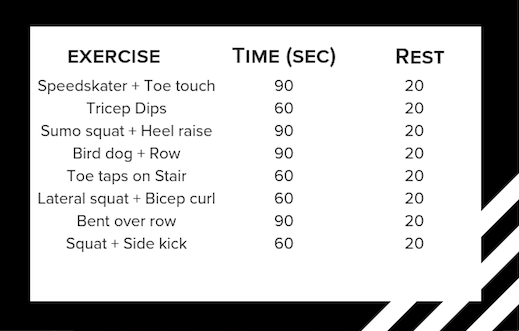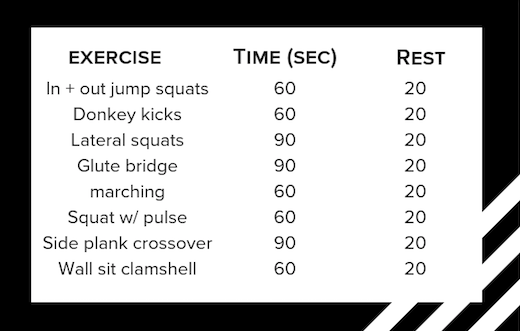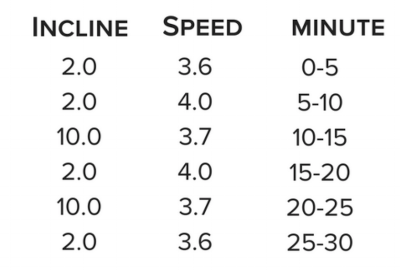Postpartum Cardio
Diaries of Cardio Queens Reformed
For an athlete, there is nothing like the feeling of getting that heart rate up and pumping. Not a bad thing, because there are some amazing health benefits to cardio. Amy and I are big cardio lovers, however prioritizing strength is essential during the postpartum period. There is much stretngth training that needs to occur to rebuild your body from the inside out so that you can sign up for a 5K or marathon soon! It is imperative that we progress properly back into exercising post baby. Below are our cardio recommendations based on evidenced based research, clinical expertise and personal experience. We recommend shooting for twice a week for 30 minutes.
Benefits of Cardio
You are probably already aware that cardiovascular exercise is good for your heart, but there are so many more physiological benefits. For one, it increases your energy level so that you are able to keep up with your kiddos. An increased energy level leads to an increase in the enzymes that aid in burning fat and carbohydrates, so it also helps to regulate your weight. Not only do you burn calories while you are exercising but you will also burn more calories throughout the day after you exercise due to the increased level of energy. Cardiovasular exercise also helps your body to release tension fighting hormones, such as serotonin, dopamine, and norepinephrine to combat stress and anxiety. If you spend much of your days sitting, exercise will help slow and can actually reverse many of the negative effects of a sedentary lifestyle and aging. Not to mention it will help you fall asleep faster and promotes REM sleep (note: just try not to work out too close to bed time otherwise you may get too energized to fall asleep!). There are so many more benefits of cardiovascular exercise I could go on for days so I’ll just leave it at that- so get those tennis shoes on and go!!
Postpartum Sweet Spot (skip if you are not breastfeeding)
Attention milk producing mamas: Milk supply can be an enormous worry for exercising mamas. We wanted to clear up any misconceptions and give you the facts. The good news is that there are studies out there that show there is NO difference in milk production or milk composition between exercising and sedentary mamas.₁ However, research has shown that high intensity exercise can actually decrease your milk supply.₁,₂ (The Expecting and Empowered Postpartum Strength Training Program is NOT considered high intensity exercise.)
There is no doubt that breastfeeding mamas can successfully produce enough milk for their babies AND exercise. However, there are considerations to be made. If you are creating too big of a caloric deficit (by exercising and producing milk) you may need to up your food intake. We would highly suggest doing this in a healthy way.
When engaging in exercise postpartum, your fluid intake is also very important. Your hydration status should be assessed several times during the day. Your urine should be very light in appearance (straw-colored or clear). If it is not, increase your water intake. Postpartum moms may need 12 or more glasses of water a day.
There is a sweet spot for intensity of exercise postpartum. You want your heart rate high enough for fat burning and physiological benefits but high intensity exercise can have a negative effect on milk production. HIIT workouts or high intensity interval training is very popular at the moment and while interval workouts are an amazing way to burn calories, this may not be the best option for breastfeeding moms. The HIIT workouts can still be done but I would focus on keeping your heart rate 60-80% verses the 90% recommended for high intensity exercise.
On the flip side of the coin, you still want to make sure you are pushing yourself hard enough to hit that sweet spot of 60- 80%. You should still be pushing pretty hard. Interval training is great for increasing the intensity of your workouts. Interval workouts are when you push hard for a set time, back it down for a set time, then go hard again. Below we have some examples for you.
When starting your exercise routine: If you are breastfeeding, your baby should be progressively gaining weight and feeding normally before beginning an exercise program. Once you get back to exercising if you are concerned, track your baby’s weight and your milk production. Make sure your baby has a normal number of wet diapers each day.
How to Calculate your Target Heart Rate
General guidelines for calculation your target HR is: 220- age, multiplied by 0.6-0.8.
60%-80% of your max heart is the fat-burning zone which is where you want to be for many of your workouts.
So for example, if you are 30 years old, 220 - 30= 190. Low range (60% of 190 is) 114 and high range (80% of 190 is) 152.
Therefore you want to fall somewhere within the range of 114- 152 when you are exercising.
The image to the right is your perceived rate of exertion. You can use this if you don’t have a heart rate monitor. You should fall somewhere from 6 to a light 8 so your level of activity should still be pretty vigorous.
Dropping those LBS
The last important note about breastfeeding is that women who breastfeed may hold onto an extra five to ten pounds from their pre-pregnancy weight while breastfeeding. During the breastfeeding period, our hormones make our bodies less efficient at burning fat. Simply put: high prolactin from nursing will lower your estrogen, lack of ovulation will lower progesterone. Low estrogen and progesterone are responsible for our bodies to want to hold onto fat. Also, when we do not get enough sleep our bodies crave carbs and sugar. When we give into those cravings it will result in an insulin spike. When insulin is released in the body, it causes fat to get stored.
Don’t give yourself a 500+calorie justification for eating not so good for you foods, of which I am SO FRICKEN GUILTY: my Starbucks refreshers and chai lattes are keeping those rolls on my belly. Try to opt for better foods: more protein, more healthy fats. My main point: Don’t cut calories by eating less. Your main job really is to nurture your baby. Just make better choices. I know first hand how difficult this is!
Your time is limited so work out smart: Skip the longer duration cardio and too much intense exercise. Low estrogen makes the long duration cardio effective. STRENTGH is key during this time. Our workout programs were all written with this in mind- check out the Postpartum Strength Training Program here
Trust that it will likely get easier after you stop nursing. Your hormones will change and you should be able to drop the last few lbs. Remember that it’s just a phase mamas!
CARDIO EXAMPLES
Types of cardio during postpartum:
Walking
Treadmill- incline workouts
Swimming
Elliptical
Rowing Machine
Stationary Bike
Low to moderate impact aerobics- can do this at home with minimal equipment
And eventually…running!
Running
We would not suggest running until 12 weeks postpartum. During that 12 weeks there is so much you can be doing to rebuild your strength so that running is a breeze when you hit the pavement. But why should you wait so darn long? Running is high impact and a repetitive force through our bodies and if our core, pelvic floor and muscles are not ready for this it can leave us with poor running form, which leads to injuries.
New research out of The University of Wisconsin is showing that the body changes that occurred to runners during pregnancy last for quite awhile after too. These body changes alter your stride, making you less efficient and more susceptible to injury. These types of injuries are caused by excessive force that would normally be absorbed by properly positioned muscles, but due to the changes caused by pregnancy could actually cause bony structures and soft tissue to break down. In these studies, common running injuries in pregnant women included: low back pain, buttock symptoms (numbness and tingling), high hamstring pulls and knee pain. With this new research we can make educated decisions on what should and should not do postpartum to decrease the negative effects on our bodies after babies.
Stroller form with running
Making sure handles are where you want them- elbow at a 90 degree angle is a good starting point
Notice if you have an arm that comes back more easily when running, hold the stroller with that side more often to help the other side learn how to work better. At least be mindful of switching what side holds the stroller (start at 50-50 if unsure)
Focus on extension in hips and arms!
Caution about bearing down or putting pressure downward on the stroller— this compensation is common if your core is weak. Downward pressure through your arms creates downward pressure on your pelvis potentially leading to urine leaking and prolapse
Keeping your body close to the stroller— pelvis is close and you have a forward lean to your body
Striding it out (letting go of the stroller if it is stable)
Run without baby or dog periodically— stroller running is pretty unnatural, it is important to remind yourself and your body what “normal running” is!
HOW DO I MINIMIZE THE CHANGES?
Strength training, flexibility, and recruitment of deep abdominal, hip, low back and pelvic floor muscles are imperative to running longer and more comfortably into pregnancy with fewer problems postpartum.
No matter which form of cardio you choose:
Be sure every workout includes a warm up, cool down and a few minutes of stretching before and after exercising.
Hydrate before, during and after your workout
Listen to your body
Take a break during your cardio of needed
If you feel dizzy, short of breath or experience vaginal bleeding or pain of any kind, stop exercising immediately and call your doctor if the symptoms don’t go away.
Examples of Cardio Workouts
At home cardio- Circuit workout 1
Performing a circuit workout at home can be done without any equipment. The following circuit is good to do after 15 weeks postpartum. Perform each exercises vigorously for the time stated, rest for 20 seconds, then move on to the next one and repeat the circuit three times through
At home cardio- circuit workout 2
This full body workout can be done at 6 weeks postpartum. Perform each exercise for repetitions listed. Complete the list 3 sets.
At home cardio- circuit workout 3- Circle band workout
Can be performed at 12 weeks postpartum. Do each exercise for the time stated and repeat circuit 3-4x! You can do a killer workout with bands. They’re such a simple way to add more resistance. Note: do not jump if you have a prolapse, do not do side planks if you have DR
At home cardio- circuit workout 4
Can be performed at 20 weeks postpartum. 40 seconds work/20 seconds rest. Repeat circuit 3x. Do not perform plank jacks if you have DR.
At home cardio- circuit workout 5- Cardio Blast
Perform at 20 weeks postpartum or beyond. Repeat each exercise as many times as you can for 40 seconds (with good form), rest 20 seconds, and repeat. Repeat the circuit 3x or 4x. This is not a good cardio workout if you have stress urinary incontinence or prolapse or DR.
At home cardio- circuit workout 6
Safe to perform at 20 weeks postpartum. Do not jump if you have urinary stress incontinence or prolapse. 40 seconds work (repeat the exercise as many times as you can, with good form) and 20 seconds rest. Repeat circuit 5x.
TREADMILL WORKOUTS
Treadmill incline workout 1
Treadmill incline workout 2
Treadmill incline workout 3
Click Here for a PDF of the workouts
References
Dewey KG, Lovelady CA. Exercise and breastfeeding: a difference experience. Pediatrics. 1993; 91:514-515.
Dewey KG, McCroy MA. Effects of dieting and physical activity on pregnancy and lactation. Am J Clin Nutr. 1994; 59: 446S-453S.
Figures CC, Boyle KL, et al. Pelvic floor muscles activity and urinary incontinence in weight-bearing female athletes vs. non-athletes. JWHPT. 2008; 32: 7-11.
Handa V, Harris T, Ostergard D. 1996. Protecting the pelvic floor: Obstetric management to prevent incontinence and pelvic organ prolapse. Obstetrics and Gynecology 88;470.
Kane, Sioban L., “Does Exercise Alleviate the Symptoms of Postpartum Depression?” 2012. PCOM Physician Assistant Studies Student Scholarship. 70.
Lovelady C, Lonnerdal B, Dewey K. Lactation performance of exercising women. AmJ Clin Nutr. 1990; 52: 103-109.
Thein-Nissenbaum JM1, Thompson EF, Chumanov ES, Heiderscheit BC. Low back and hip pain in a postpartum runner: applying ultrasound imaging and running analysis. J Orthop Sports Phys Ther. 2012 Jul;42(7):615-24










